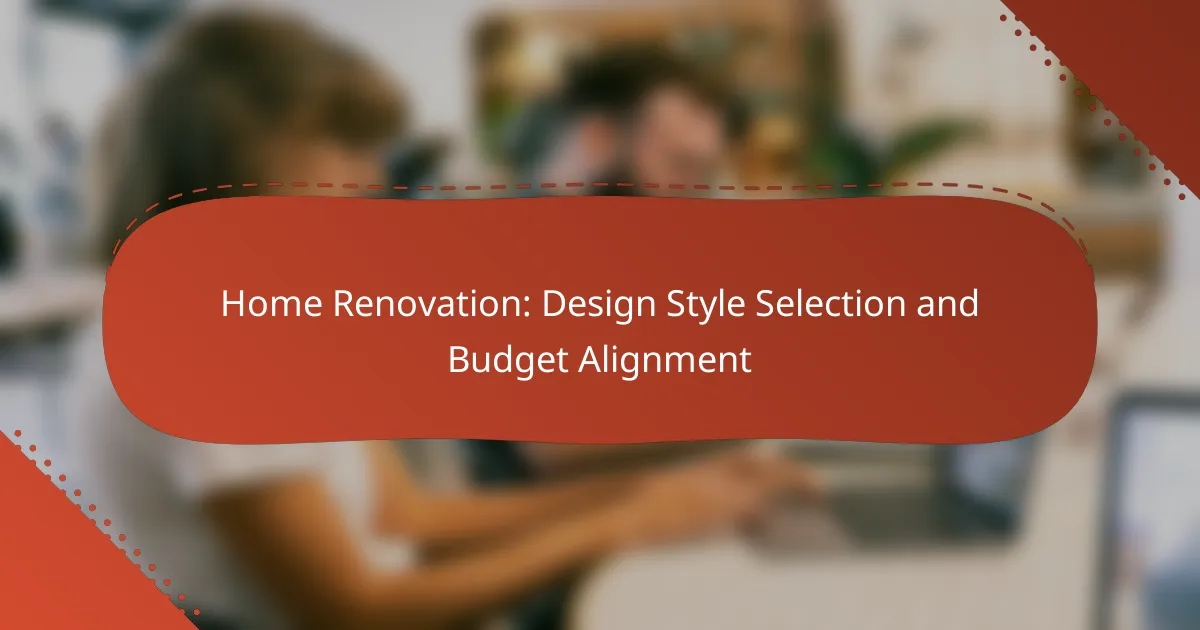Home renovation offers an exciting opportunity to transform your living space, but selecting the right design style is crucial for achieving your desired aesthetic and functionality. With various popular styles like Modern, Farmhouse, and Mid-century Modern, it’s essential to align your budget with your design choices to ensure a successful project. Careful planning and consideration of personal preferences, neighborhood characteristics, and potential resale value will help you create a cohesive and appealing environment that meets your renovation goals.

What design styles are popular for home renovation in the US?
In the US, several design styles dominate home renovation projects, each offering unique aesthetics and functionality. Popular styles include Modern, Farmhouse, Mid-century Modern, Industrial, and Traditional, each catering to different tastes and budgets.
Modern design
Modern design emphasizes clean lines, minimalism, and a neutral color palette. This style often incorporates large windows and open spaces, creating a sense of airiness and light. When renovating, consider using materials like glass, steel, and concrete to achieve a sleek look.
To align your budget with modern design, focus on key elements such as furniture and fixtures that embody simplicity. Avoid excessive ornamentation to keep costs manageable while maintaining the style’s essence.
Farmhouse style
Farmhouse style is characterized by its cozy, rustic charm, often featuring wood accents, vintage decor, and a warm color palette. This design is perfect for creating a welcoming atmosphere, emphasizing practicality and comfort.
When renovating in this style, consider incorporating reclaimed wood, shiplap walls, and farmhouse sinks. Budget-friendly options include DIY projects for furniture and decor, which can enhance the authentic feel without overspending.
Mid-century modern
Mid-century modern design is known for its organic shapes, functional furniture, and integration with nature. This style often features bold colors and geometric patterns, creating a vibrant yet harmonious living space.
To achieve this look, focus on iconic furniture pieces and decor that reflect the era’s aesthetic. Budget considerations may include sourcing vintage items or replicas, which can provide authenticity without breaking the bank.
Industrial design
Industrial design draws inspiration from warehouses and factories, showcasing raw materials like exposed brick, metal, and wood. This style often features an open floor plan and a neutral color scheme, creating a modern yet rugged look.
When renovating, consider using salvaged materials and industrial lighting fixtures to enhance the aesthetic. Keep costs in check by focusing on structural elements rather than extensive decor, allowing the materials to speak for themselves.
Traditional style
Traditional style is rooted in classic design principles, featuring rich colors, ornate details, and a sense of symmetry. This style often incorporates antique furniture and decorative moldings, creating a timeless elegance in any home.
For a successful renovation, prioritize high-quality materials and craftsmanship. While traditional elements can be more expensive, consider investing in key pieces and complementing them with more affordable decor to balance your budget.

How to align your budget with design style choices?
Aligning your budget with design style choices involves understanding your financial limits while selecting a style that meets your aesthetic and functional needs. This process requires careful planning, prioritization, and research to ensure that your renovation goals are achievable without overspending.
Set a realistic budget
Establishing a realistic budget is the cornerstone of any home renovation project. Start by determining how much you can afford to spend, considering your savings and potential financing options. A common guideline is to allocate 10-15% of your home’s value for renovations, but this can vary based on your specific goals and the condition of your home.
Include all potential costs in your budget, such as materials, labor, permits, and unexpected expenses. It’s wise to set aside an additional 10-20% as a contingency fund to cover any surprises that may arise during the renovation process.
Prioritize essential renovations
Identifying and prioritizing essential renovations helps you allocate your budget effectively. Focus on improvements that enhance safety, functionality, or energy efficiency, such as updating electrical systems, plumbing, or insulation. These upgrades often yield a higher return on investment and can significantly improve your living conditions.
Once you’ve addressed the essentials, consider which aesthetic upgrades are most important to you. This might include kitchen or bathroom remodels, which typically offer good value when it comes to resale. Make a list of desired renovations and rank them based on necessity and impact.
Research material costs
Understanding material costs is crucial for aligning your budget with your design choices. Prices can vary widely based on quality, brand, and availability. Research local suppliers and compare prices for materials like flooring, cabinetry, and fixtures to find the best deals.
Consider using cost-effective alternatives that still achieve the desired look. For example, laminate countertops can mimic the appearance of granite at a fraction of the cost. Online resources and local home improvement stores can provide insights into current trends and pricing.
Consider DIY options
Incorporating DIY options can significantly reduce labor costs and help you stay within budget. Assess your skills and the complexity of the tasks at hand; simple projects like painting or landscaping can often be done without professional help. However, for more complex renovations, consider hiring professionals to ensure quality and compliance with local building codes.
Before starting any DIY project, gather the necessary tools and materials, and take the time to research techniques. Online tutorials and workshops can provide valuable guidance. Just be cautious not to overestimate your abilities, as mistakes can lead to costly repairs.

What are the key factors in selecting a design style?
Selecting a design style for home renovation involves balancing personal preferences, architectural features, neighborhood characteristics, and potential resale value. Understanding these factors can help create a cohesive and appealing space that aligns with both your vision and practical considerations.
Personal taste
Your personal taste is the most significant factor in choosing a design style. Consider what styles resonate with you, whether it’s modern, traditional, rustic, or eclectic. Look through design magazines, websites, or social media platforms for inspiration and identify elements that attract you.
Make a mood board to visualize your preferences. This can include colors, materials, and furniture styles that appeal to you. Remember that your home should reflect your personality, so prioritize what makes you feel comfortable and happy.
Home architecture
The architectural style of your home plays a crucial role in determining suitable design styles. For instance, a Victorian home may not harmonize well with ultra-modern decor. Assess your home’s existing features, such as moldings, windows, and layout, to guide your design choices.
Consider maintaining or enhancing architectural elements that define your home. If you have a mid-century modern house, incorporating retro furnishings and color palettes can enhance its character while ensuring consistency throughout your renovation.
Neighborhood aesthetics
Neighborhood aesthetics can influence your design style selection significantly. Homes in a cohesive neighborhood often share similar architectural styles and design elements. Research the common styles in your area to ensure your renovation complements the surrounding homes.
While you can express your individuality, consider how your choices may affect the overall look of the neighborhood. A home that stands out too much may not only look out of place but could also impact its marketability in the future.
Resale value considerations
When selecting a design style, consider its potential impact on resale value. Certain styles may appeal to a broader audience, making your home more attractive to future buyers. Neutral colors and classic designs often have a wider appeal compared to highly personalized or niche styles.
Consult local real estate trends to understand what styles are currently popular in your area. Investing in timeless design elements can enhance your home’s value while ensuring it remains appealing to a variety of potential buyers down the line.

How can you manage renovation costs effectively?
Managing renovation costs effectively involves careful planning and strategic decision-making. By obtaining multiple quotes and utilizing budget management tools, you can ensure that your expenses align with your design goals while avoiding overspending.
Obtain multiple quotes
Gathering multiple quotes from contractors is essential for effective cost management. This practice allows you to compare pricing, services, and timelines, helping you identify the best value for your renovation project.
When requesting quotes, provide each contractor with the same project details to ensure consistency. Aim for at least three quotes to get a comprehensive view of potential costs, which can vary significantly based on the contractor’s experience and local market conditions.
Use a renovation budget app
A renovation budget app can streamline your financial planning by tracking expenses and managing your budget in real-time. These apps often provide features like expense categorization and progress tracking, which can help you stay on top of your spending.
Choose an app that suits your needs, whether it’s a simple spreadsheet tool or a more comprehensive budgeting platform. Many apps allow you to set budget limits and receive alerts when you approach them, helping you avoid unexpected costs during your renovation.
